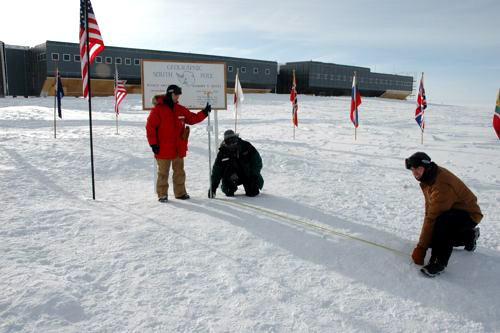|
The shadow knowsSchool science project enlists help from USAP participantsPosted January 9, 2009
It all started with a science fair project at James Monroe Middle School “It’s turned into this monster. I don’t know what happened. It’s like a snowball,” said Haste, an eighth-grade physical sciences teacher at James Monroe who also teaches earth sciences in the summer at the Johns Hopkins University's Center for Talented Youth The story goes something like this: Last year, Haste encouraged two of her students, Samir Farmer and Shelby Cluff, to do a science fair project that would measure the shadow cast by a stick as the seasons waxed and waned. The questions the students wanted to answer: Does the shadow really grow shorter in the summer and longer in the winter? To help answer the former, they enlisted the help of U.S. Antarctic Program Al Baker, South Pole Science Support coordinator, helped take weekly measurements for the project throughout the austral summer — right at the geographic pole, which marks 90 degrees south latitude. “It is gratifying to us to encourage the latest generation of future scientists,” Baker said via e-mail from the South Pole. “We hope to see them on the Ice in the near future.” The effort won the students the right to compete at a regional science fair. “They didn’t get any further, but they had a really good time,” Haste said. “It was the first time anybody from our school went to regionals.” This year, Haste recruited four students — Olander, Shannon Hamilton, Meagan Richards and Dylan Terry — to repeat the experiment. ANDRILL Haste and Olander presented their findings Dec. 17 at the AGU, which boasts a membership of 50,000 scientists, teachers and students. Haste said Olander, 14, is one of the youngest students to present at the AGU conference. The school experiment requires the students to commit to a long-term goal, according to Haste. The group usually meets twice per week during lunch breaks to discuss their data. “I kept going with it because I saw a need for it and wanted to see what we could do with it and who we could get to talk to us,” Haste said. “If we can get [the students] to do something that takes longer than a month, and they actually see the progress in it, then they’re more likely to focus on long-term projects when they get to high school.” It’s all about the kids — but their teacher enjoys some satisfaction as well. “Projects like this keep me going. I get up in the morning and I look to see who has written me from the South Pole or Palmer,” Haste said. “I get excited. I want to do it. I want to be there every day to find out what’s new.” |



For USAP Participants |
For The Public |
For Researchers and EducatorsContact UsU.S. National Science FoundationOffice of Polar Programs Geosciences Directorate 2415 Eisenhower Avenue, Suite W7100 Alexandria, VA 22314 Sign up for the NSF Office of Polar Programs newsletter and events. Feedback Form |


